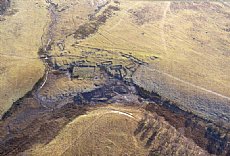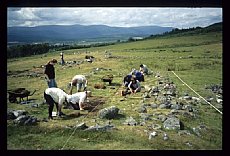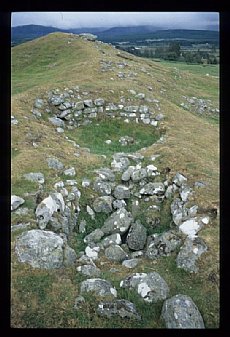Easter Raitts township
10 April 2021
- News Type:
- Site of the Month

Although the Highlands is dotted with deserted townships and houses, few have been surveyed and excavated. An exception is the important work at Easter Raitts in Badenoch (MHG4411) which was excavated in part to help inform the building of houses at the Highland Folk Museum. The settlement contained at least 18 remains of structures, with excavations revealing a complex series of changing structures and uses.
A platform revealed sherds of prehistoric pottery, including Beakers and a flint blade of probable Neolithic date, indicating prehistoric occupation in the area. Finds in this area also included a piece of carbonised crab apple, a rare find in Scotland.
Documentary evidence shows that the area was first cleared in 1803, but there are hints of Medieval settlement in the area, including a 13th century chapel at Raitts. West Rait, Mid Rait and Rait are depicted on the Pont map from the late 16th century. Other documentary evidence including rentals survives from this period onwards. Below the slope of the township ran Wade’s military road, and the establishment of nearby Ruthven Barracks would have resulted in soldiers from the south in the area.

Photo: Highland HER
The archaeological remains reflect the last decades of the township. Buildings were mainly longhouses with double skin of drystone foundations and earth/rubble core, some with evidence of turf walls. The largest investigated showed signs of reuse and remodelling, and included a byre section, and possibly a dairy area. A second excavated longhouse appears to have been re-used for animals in a later phase. Other buildings were interpreted as byres. Altogether these show the importance of animals to the inhabitants. Farrowing pens, suggesting keeping of pigs, was also found (Noble 2003, 50). There was also

evidence of clay quarrying and the construction of a puddling pool; the clay could have been used for a number of purposes. Other industrial evidence is tap slag and furnace lining, though in situ evidence of iron working was not found. This material was found on a platform which also had the redeposited prehistoric lithics and pottery. No dating was obtained for this activity.
Interior remains included possible remains of hurdles for screens, and perhaps even a turf seat (which preserved fragments of clay tobacco pipe). Floors were of beaten earth. Artefacts preserved in the interior of the main longhouse included 18th century pottery, part of an iron cooking pot, a musket flint, brass buttons and a flat iron, suggesting either a hasty departure or later use as a midden.
Along with excavations at Rosal in Sutherland (MHG11549; Fairhurst 1967-1968) and survey of the well preserved remains at Glendrian on Ardnamurchan, Lochaber (MHG17470; Birch and Peteranna 2011), the work at Easter Raitts provides important insights into Post-Medieval settlements in the Highlands.
Further Information
Lelong, Olivia and Wood, John 2000 ‘A township through time: excavation and survey at the deserted settlement of Easter Raitts, Badenoch, 1995–99’, in Atkinson, J A, Banks, I, and MacGregor, G (eds.), Townships to Farmsteads: Rural Settlement Studies in Scotland, England and Wales, BAR British Series 293: Oxford, 40–49.
Highland HER MHG4411 which has links to data structure reports and a number of photogeraphs.
Site of the Month Archive
- 10/04/2021 Easter Raitts township
- 02/03/2021 Lower Slackbuie, Inverness (ASDA) Neolithic site
- 01/02/2021 Balnuaran of Clava cairns
- 04/01/2021 Wilkhouse Inn
- 02/12/2020 Spinningdale Cotton Mill
- 02/11/2020 Skibo A Canadian Forestry Camp
- 01/10/2020 WWI Detonator Store, Dalmore near Invergordon
- 03/09/2020 Mesolithic Shell Midden at Sand, Wester Ross
- 08/08/2020 Kinbeachie Neolithic settlement
- 01/07/2020 Armadale Cist Burial and Stone & Timber Complex
